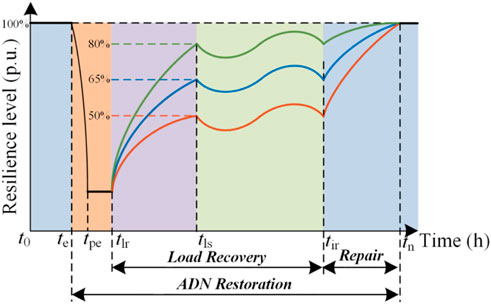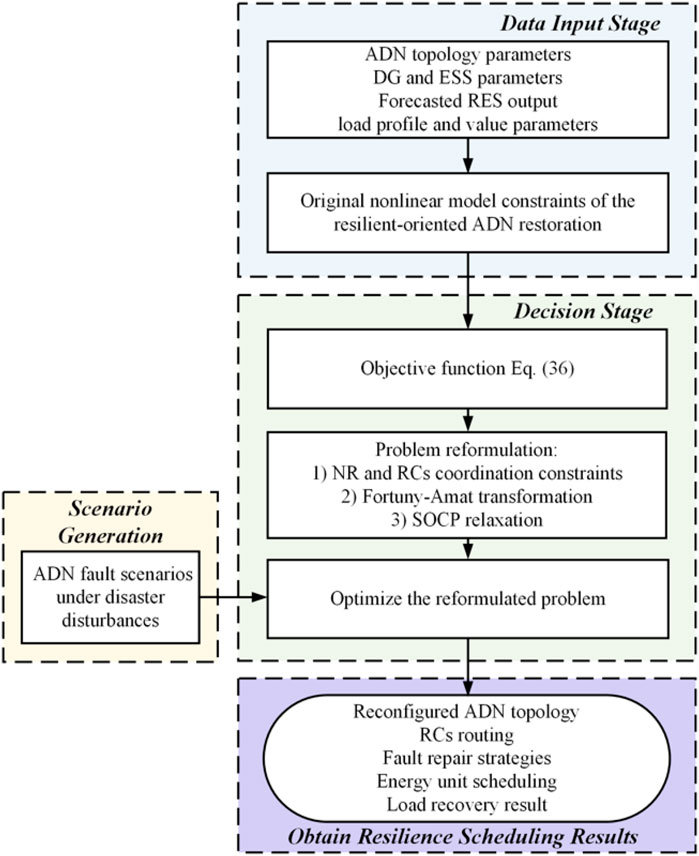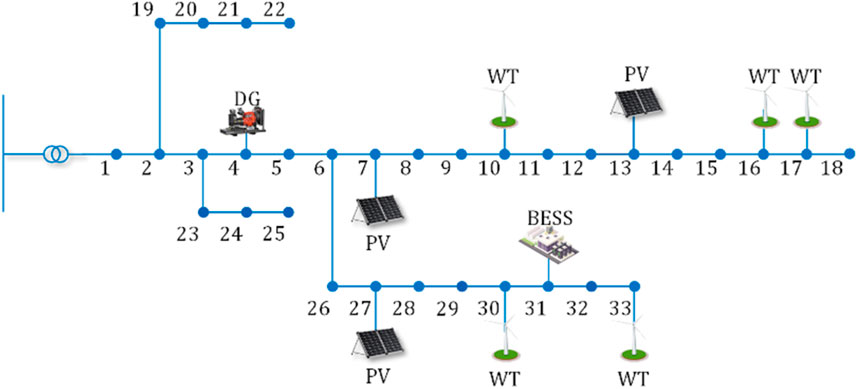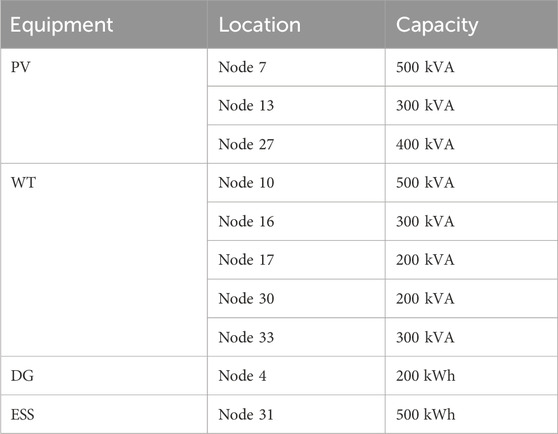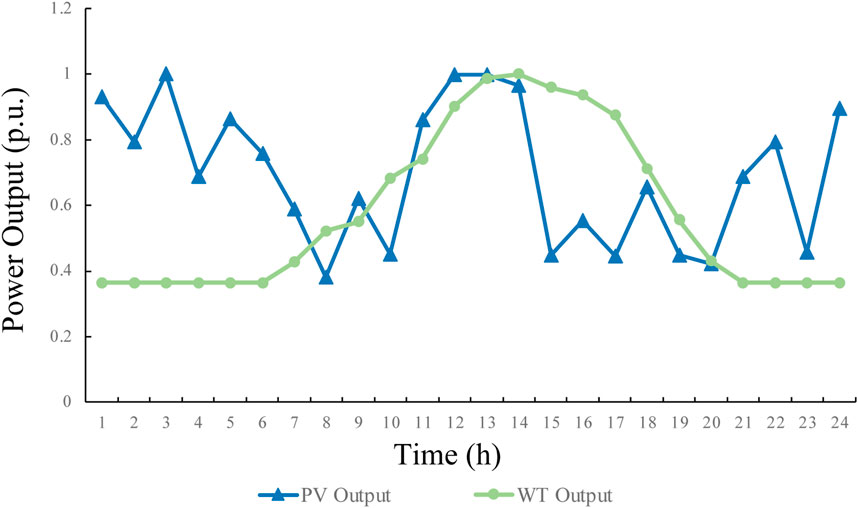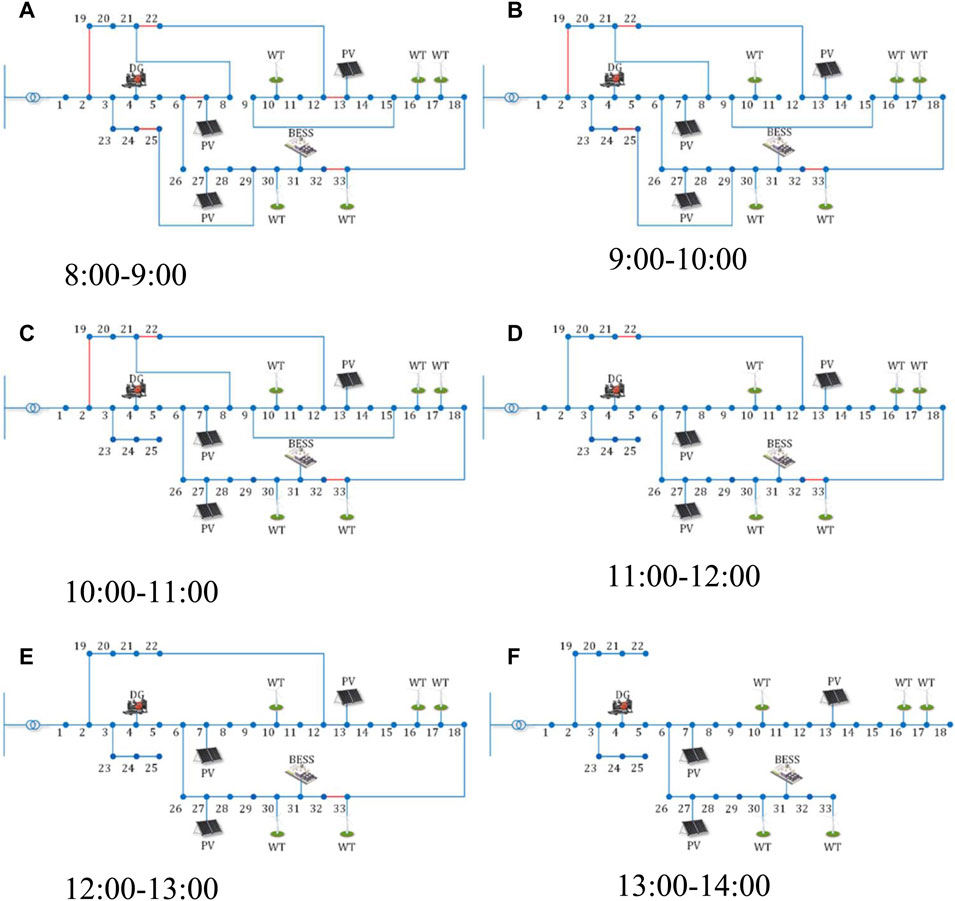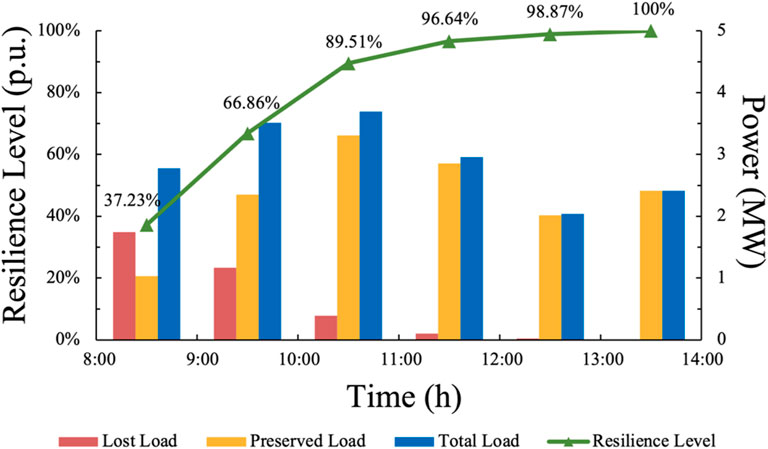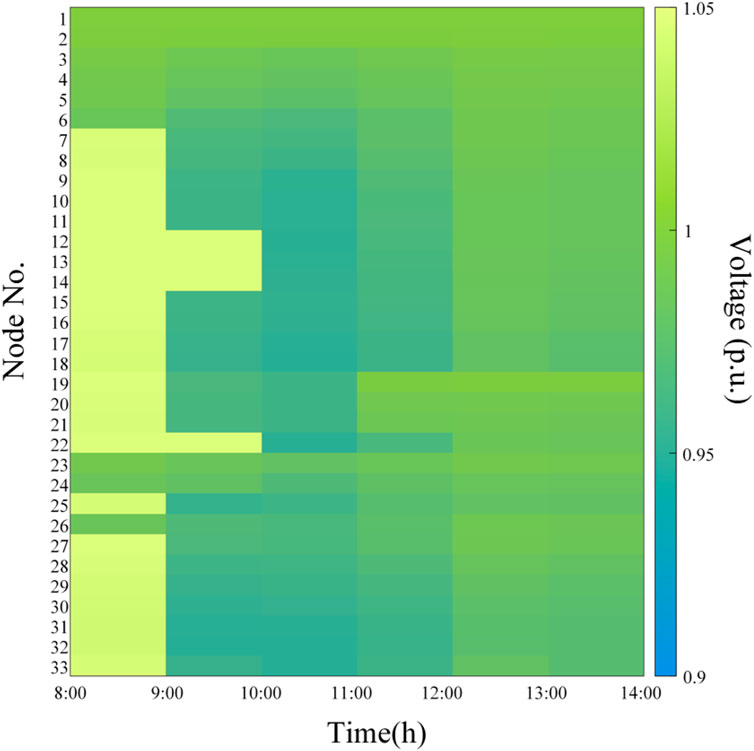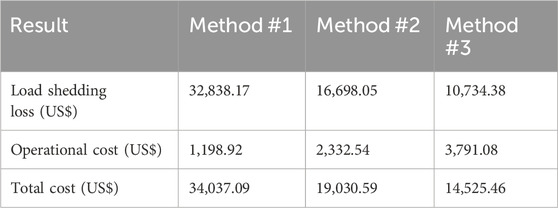- 1State Grid Suqian Power Supply Company, Suqian, China
- 2State Grid Xuzhou Power Supply Company, Xuzhou, China
- 3College of Energy and Electrical Engineering, Hohai University, Nanjing, China
- 4State Grid Jiangsu Electric Power Co., Ltd., Nanjing, China
This paper introduces a post-disaster load restoration approach for the distribution grid, utilizing network reconfiguration (NR) and dispatching of repair crews (RCs) to significantly enhance grid resilience. We propose an RC–NR coordinated model that leverages diverse flexible resources within the active distribution network (ADN), aimed at not only enhancing the grid’s resilience level but also efficiently mending the fault lines. The model introduces fault repairing and sequential NR coupled constraints to devise an optimal resilience strategy within temporal domain cooperation, focusing on minimizing repair and penalty costs associated with the restoration process. To tackle the challenge of computational complexity, the nonlinear model is reformulated into a mixed-integer second-order cone programming model. The efficacy of the approach is validated through case studies on an IEEE 33-bus system, in which simulation results demonstrate a considerable improvement in grid resilience, achieving optimal load recovery with reduced restoration time and costs. The proposed approach outperforms traditional methods with optimal repair sequence and RC scheduling, aligned with NR efforts, and contributes to an improved system resilience level.
1 Introduction
In recent decades, a series of frequent and severe extreme events, exemplified by incidents like the 2021 Texas power blackouts (Zhang et al., 2022), the Zhengzhou flood blackouts, and the Taiwan rolling blackouts in 2022, have had a profound impact on grid resilience (Perera et al., 2020). These occurrences have resulted in energy deficiencies and prolonged power interruptions, posing a severe challenge to the power system operation. Concurrently, the power distribution network is undergoing a significant transition from the traditional network to the active distribution network (ADN). Explicitly highlighted during the 2008 International Large Power Grid Conference, the ADN possesses the capability to autonomously control and manage locally distributed energy resources (DERs), adjusting the network topology in real time based on the system operational status to precisely regulate the power flow (Li et al., 2017). This concept has been consistently embraced within the academic community. It is crucial to emphasize that unlike the autonomy of microgrids, under normal circumstances, the ADN, as a public distribution network managed by power companies, does not permit islanded operation. However, in emergency situations, a judicious configuration of switching points can enable specific areas of the ADN to function as isolated microgrids in an unconventional manner to support the ADN operation (Konakalla et al., 2019). Therefore, leveraging the resources within the ADN to enhance its resilience against extreme natural disasters is of paramount significance, aiming to mitigate economic losses caused by power outages.
As the foundation for the resilience operation of the ADN, it is crucial to model and evaluate the fault scenarios caused by extreme disasters. Typhoons are one of the most frequently occurring extreme disasters. Mu et al. (2022), using the classic Batts typhoon model, obtained time-varying wind speed curves at various points of the lines. Combining the vulnerability model of distribution network components, they generated fault scenarios using a non-time-series Monte Carlo simulation method. Hussain et al. (2019) considered the spatial distribution characteristics of faulty and outage equipment under typhoon disasters, categorizing them into centralized, decentralized, and centralized–decentralized distributions. They generated a set of fault scenarios for the ADN based on the fault rate distribution functions of different typhoon grades. Hou et al. (2021), starting from historical data on typhoon damage, established a prediction and evaluation model for user power outage grids under typhoon disasters using data mining and grid partitioning methods. Building upon classical models, Hou et al. (2023) made uncertainty improvements to the typhoon wind field and line fault models, considering the effects of diverse wind speeds. They proposed an improved model for line stress interference. In summary, the existing models describe the time and space characteristics of typhoons, analyze the impact mechanism of extreme disasters on distribution networks, and ultimately determine damaged scenarios by establishing component vulnerability models. These above research studies provide the fundamental models and methods for evaluating the potential faults of extreme disasters, which contributes to further investigation of the resilience operation methods.
To deal with the extreme disasters, the main measures adopted include network reconfiguration (NR) and emergency islanding. The ADNs are generally designed as closed-loop systems but operate in an open-loop manner to improve the reliability of the system. This characteristic provides a prerequisite for the implementation of network reconstruction and islanding. The NR involves the rational configuration of tie points, remotely activating or deactivating the corresponding circuit breakers, allowing specific local areas of the distribution network to operate as microgrids in an abnormal state. By this measure, the critical loads can be supplied to avoid economic losses. Demetriou et al. (2016) and Liu et al. (2019a) formulated the islanding division and power output adjustment problem as a mixed-integer linear programming model. They determined optimal islanding strategies by first obtaining a DC-feasible solution and then determining the operating point for AC steady-state islanding. Hafez et al. (2018) proposed a novel method for radial network constraints suitable for the flexible reconstruction of distribution networks. This method significantly enhances the flexibility of the network topology, thereby improving the feasibility and optimality of optimization problems related to reconstruction. Liu et al. (2019b) comprehensively considered proactive fault islanding and restoration. Lei et al. (2020) proposed a novel approach for radiality constraints, which fully enables the topological and some other related flexibilities of systems. However, only adjusting the grid structure is insufficient. The faults caused by the restoration should be inspected and repaired timely to reduce the duration of the faults and power outage. Hence, it is of great significance to consider the dispatching of the repair crews (RCs) to repair and restore the ADN against extreme disasters.
The RCs stand out as crucial resilience enhancement forces that find wide applications in distribution networks. Specifically, RCs play a vital role in facilitating coupling repair and restoration processes. Efficiently dispatching RCs to repair specific damaged components is essential for fully restoring a power grid following disasters, thereby supporting the network restoration of distribution networks (Van Hentenryck et al., 2011; Zhang et al., 2020). Bian et al. (2021) proposed a RC deployment model for fault repair and system restoration by solving a two-stage stochastic optimization problem. Arif et al. (2017) delved into the co-optimization of RC routing and reconfiguration for distribution network restoration. Considering the resource capacity limits, the fault repair and restoration model was proposed by Shi et al. (2022) to optimize the scheduling for RCs to repair faulted lines. Notably, recent studies have explored strategies such as coordinating energy scheduling with dynamic microgrid formation to reduce post-disaster recovery costs and co-optimizing RC routing with ADN reconfiguration for efficient restoration (Yao et al., 2019; Yao et al., 2020). However, existing research often addresses NR and RCs in isolation. Nevertheless, RC dispatching in the aftermath of extreme disasters poses a significant challenge as it involves addressing the combinatorial optimization issues related to depot location, equipment transportation, allocation, and crew assignment (Golshani et al., 2019; Inanlouganji et al., 2022). Thus, how to tackle the coordination between RC dispatching and NR is still a remaining key issue.
However, these works mentioned above still have two challenges to overcome: one challenge is how to enhance the resilience level of the ADN with accurate fault scenarios. The other challenge is how to solve and obtain the NR and RC repair and restoration scheduling for the ADN against extreme disaster scenarios. Based on the above, the contributions of this paper are concluded as follows:
1) The RC dispatching and fault repair sequence model is proposed to reduce the fault time period and the corresponding economic losses under extreme disasters. RC numbers and material capacity limits are modeled as constraints to describe the repair decision, while the fault repair sequence constraints are also integrated in the model to obtain optimal repair scheduling.
2) The RC and NR coordinated ADN operation method is devised to support critical loads and reduce the economic loss during the fault periods. Compared with conventional methods, the proposed method can effectively achieve optimal repair routing and load recovery scheduling for a fast and secure restoration.
2 Resilience-oriented ADN restoration framework
The conceptual resilience curve is illustrated in Figure 1. The ADN’s resilience level is measured by the ratio of the supplied load. Before and after the extreme event, the ADN typically encompasses five states: pre-event (
In this study, we propose a resilience-oriented ADN restoration approach where fault scenarios are generated before extreme events by the proposed fault possibility model. Then, the RC and NR coordinated load restoration problem is solved to obtain the optimal ADN restoration scheduling during the post-event, restoration, and post-restoration states until all the faults are repaired. Hence, the proposed resilience-oriented ADN restoration framework can leverage all the resources, including the power supply, system topology adjustment measures, and RCs, to effectively enhance the resilience level against a disaster.
3 Resilience-oriented ADN restoration model
In this study, in order to supply critical loads, the ADN makes use of strategies such as topology reconfiguration and island partition through the deployment of flexible resources. Furthermore, in the resilience-oriented ADN restoration model, local flexible resources, including controllable diesel generators (DGs), and energy storage systems (ESSs) are utilized with the distributed generation systems, such as photovoltaic (PV) systems and wind turbine (WT) systems, to provide energy to the loads in the ADN. Furthermore, line switches are operated by the DSO for NR by considering the DistFlow power flow model. Additionally, RCs are dispatched to repair the faults with limitations of the numbers and material resources.
3.1 Local flexible resources
Regarding flexible resources, both DGs and ESSs possess flexible capabilities. These are designated as the power source within the isolated islands to provide electricity for shed loads.
3.1.1 Model of the DGs
Distribution grids often rely on controllable distributed power sources, primarily utilizing DGs. DGs are commonly employed in isolated grids that are not connected to the upstream network or used as emergency power sources during grid failures. They can even be utilized in more complex scenarios such as peak shaving and power support. The model of the DGs is given in Eqs. (1)–(3) as follows:
where
3.1.2 Model of the ESSs
ESSs provide possibility and solutions for post-disaster emergency dispatch in distribution networks. They can act as a fast reserve to effectively support regional control, scheduled dispatch, frequency regulation, and peak shaving. In the distribution phase, the introduction of energy storage devices can effectively mitigate the fluctuation between uncontrollable distributed power generation and load demand. ESSs interact with the grid by controlling the charging and discharging of batteries based on received control commands. Additionally, the inverters of the ESSs have a certain reactive power support capability, providing voltage support to blackout nodes according to the operational requirements of the grid. Detailed model of the ESSs are given in Eqs. (4)–(9).
where
3.1.3 Model of the RES
Distributed RES can also be utilized to support the ADN resilience level. The corresponding model of the RES generation are represented in Eqs. (10)–(12) as follows:
where
3.2 DistFlow model of the ADN
The DistFlow model (Baran and Wu, 1989a) is typically used in the literature for simplifying the power flow equations to make them more tractable for analysis. This simplification, while enabling easier computation, can lead to inaccuracies in modeling the real behavior of the electrical distribution network, particularly under heavy loading conditions or when dealing with complex network topologies. Furthermore, the DistFlow model is primarily designed for radial distribution networks, which can be formulated as Eqs. (13)–(16):
where
In addition,
where
3.3 Model of RC dispatching and fault repair
In response to natural disasters and power line faults, the power grid needs to sequentially repair each affected line to shorten the damage period. It is crucial to find the optimal maintenance sequence within the fault period. The method for optimizing the fault repair strategy involves the introduction of a series of constraints to the switch status variables during network restructuring and island partitioning. These constraints are integrated into a unified model for fault recovery during the restructuring and islanding process. When faults occur, it ensures that the lines remain disconnected. At the same time, it is restricted to restoring a maximum of
where
Resource availability is ensured by Eq. (21), which stipulates that the resource capacity of each crew should be sufficient to meet the total resource demand of the damaged components in its assigned route:
where
3.4 Radial operation constraints of the ADN
The ADN must satisfy the following radial constraints which can be formulated as Eqs. (22)–(25):
where
4 Resilience-oriented RC and NR coordinated operational scheduling method
4.1 Model reformulation
4.1.1 Big M method
With the Big M method, the Eq. 14 can beeformulated into the following constraints in Eqs. (26)–(30):
where
4.1.2 SOCP relaxation of the DistFlow power flow model
A new set of variables
Based on above, the relaxation gap of the DistFlow model can be defined as Eq. (34).
4.1.3 SOCP relaxation of the DG and ESS
Similar to the relaxation of the DistFlow model, the SOCP relaxation of the DG and ESS are given as Eqs. (35), (36).
4.2 Objective function
The objective function of RCs repair and system restoration is formulated as Eq. (37).
where
4.3 RC and NR coordinated ADN restoration method
After the above steps, the overall RC and NR coordinated ADN restoration model can be solved using a commercial solver. Figure 2 shows the flowchart of the proposed method.
5 Case studies
To evaluate the proposed method, the IEEE 33 bus active distribution system is used (Baran and Wu, 1989b). System configuration is shown in Figure 3. Five WTs, three PVs, one set of DGs, and one ESS are integrated into the ADN. Time duration and equipment configuration parameters for the fault scenario are listed in Table 1 and Table 2, respectively. Figure 4 shows the predicted power generation curve of the PVs and WTs. The problem is solved using the MATLAB R2018b platform with Gurobi 10.0.0 (Gurobi Optimization and LLC, 2023). The results demonstrate that our approach can achieve optimal load recovery strategies within 226 s, which is computationally feasible in real-world applications.
5.1 Network reconfiguration and fault repair scheduling results
To show the importance of NR and RC coordinated resilience dispatching, the ADN topologies during the fault duration are established, as illustrated in Figures 5A–F. As mentioned in Table 1, initially, at 8:00, there are six faults in branches 6, 12, 18, 21, 24, and 32, which are marked in red in Figure 5A.
During the first fault duration period 8:00–9:00, the ADN is reconfigured into three islands as the temporary status for resilience operation. Nodes 1–6, 23–24, and 26 are in the first island that is connected to the upstream network and the DG to supply the demand. Nodes 7–8 and 19–21 are in the second island to support the local power demand using PVs in node 7. Nodes 9–18, 22, 25, and 27–33 are divided into the third island, with five WTs and the BESS in node 31 for resilience operation. In addition to the normal power line branches, four power-tie lines are all deployed to further improve the power exchange ability in the ADN to enhance the resilience level. Meanwhile, RCs are all scheduled to start the repair process of the fault lines between nodes 6–7 and nodes 12–13, which can be illustrated in the next fault duration.
During the second fault duration period 9:00–10:00, in Figure 5B, the fault in the branches between nodes 6–7 and nodes 12–13 are repaired, respectively. Then, the ADN is reconfigured into two islands for resilience enhancement. Nodes 1–11, 19–21, and 23–33 in the first island are meant to support critical loads supplied by the main grid, the DG, five WTs, two PVs, and the BESS. The second island includes nodes 12–14 and 22 to support the local power demand using the PV in node 13. Similar to the situation during the fault duration period 8:00–9:00, the four power tie line branches are all still kept closed to enhance the resilience level. Meanwhile, the RCs are all scheduled to start the fault line repair process between nodes 24 and 25.
For the third fault duration period 10:00–11:00 (Figure 5C), the fault in the branches between nodes 24 and 25 is repaired by the RCs. Hence, the ADN is mitigated into a radial network topology with all the energy units engaged. Different from the situation before, the power tie line between nodes 25 and 29 is kept open to avoid the loop circuit in the ADN.
Figure 5D shows the ADN topology during the fourth fault duration period 11:00–12:00. The RCs repaired the fault line between nodes 2 and 19, which contributes to the improvement in the ADN resilience level by increasing the power exchange ability in the network. It should be noted that constrained by the radial network topology, the power tie line between nodes 9 and 15 is opened. RCs are scheduled to start the fault line repair process between nodes 21 and 22.
Finally, as shown in Figures 5E, F, in the last duration period 12:00–14:00, the RCs repaired the last fault line between nodes 32 and 33, and after the repair process, the ADN is restored to the normal mode topology, ensuring that the system resilience level achieves a 100% recovery. Hence, the proposed NR and RC coordinated operation model can effectively improve the system resilience level by repairing the faults and operating the power line switches using the optimal strategy.
5.2 Load recovery and voltage management results
Regarding the improvement in the resilience level of the ADN, Figure 6 illustrates the resilience level and the lost load, the preserved load, and total load demands. It can be concluded that the resilience level of the ADN is improved from 37% at 8:00 to 100% at 14:00, which indicates that the NR and RC can effectively reduce load shedding. Furthermore, by repairing faults lines, the resilience level is improved by 30%, 23%, 7%, 2%, and 1%. This indicates that the optimal RC scheduling strategy can effectively obtain the maximal resilience level improvement during every repair process. Meanwhile, the decline in the lost load demand and the increase in the preserved load also prove that the proposed NR and RC coordinated operation method can effectively improve the system resilience level and eventually restore the ADN to the normal status.
Figure 7 shows the nodal voltages of the ADN at each time slot. The nodal voltages are measured by the per-unit value by setting the voltage base values to 12.66 kV. The maximum and the minimum voltages are 1.05 and 0.95, respectively. The nodal voltage is acceptable in practice, considering that the voltage limits are 0.9–1.1 p.u. It should be noted that after the repair of fault lines in each duration period, the nodal voltages in the ADN are improved to be closer to the base value, which illustrates that the proposed method can effectively secure ADN operation with the optimal repair strategy.
5.3 Result comparison
To further evaluate the proposed model and method, three methods are compared as follows:
Method #1—NR method: Only NR is considered in this method to support the load demand, and all faults are repaired at the end of the fault duration.
Method #2—NR operation method with a fixed repair sequence: The ADN resilience level is enhanced using the NR operation method, and the fault lines are repaired using a fixed sequence with the distance measured between the fault lines and node 1 in the ADN.
Method #3—NR and RC scheduling coordinated operation method: Three groups of RCs are scheduled to repair the fault lines simultaneously with NR of the ADN.
From Table 3, it can be concluded that the load shedding loss of Method #1 is larger than those of Method #2 and Method #3 with gaps of $16,140.12 and $5,963.67, respectively. This is because in Method #1, the RC repair capability is not considered. All the faults are repaired until the end of the fault duration, which weakens the power supply capacity of the ADN. In Method #2, the RCs only repair the fault lines by following the geographical distance sequence, which may lead to suboptimal scheduling routing and the increase in economic losses. Among the three approaches, Method #3 can obtain the minimal load shedding loss.
The operational cost to reduce carbon emissions increases from $1,198.92 in Method #1 to $2,332.54 and $3,791.08 in Method #2 and Method #3, respectively. This is tenable since with NR and RC coordination, more nodes in the ADN and in the same island are connected with the DG, which leads to an increase in the fuel cost of the DG.
Meanwhile, despite the increase in the operational cost of Method #3, the total costs of the three methods are $34,037.09, $19,030.59, and $14,525.46, respectively. Therefore, the proposed Method #3 achieves the best performance in reducing the total cost of load shedding and system operation. Thus, the resilience of the ADN is effectively enhanced, and the proposed NR and RC coordinated method can reduce the economic loss caused by disasters.
6 Conclusion
In this paper, a resilience-oriented operational scheduling method is proposed by coordinating RCs and NR within an ADN to effectively counteract faults. Compared to traditional methods, this method not only establishes power supply islands but also ensures continuous power delivery to critical loads during blackouts by strategically deploying local and external resilience resources and RCs. The synergy between NR and RCs is meticulously orchestrated to simultaneously determine the repair sequence of fault lines and the reconfiguration of the ADN topology. The effectiveness of our approach is demonstrated through numerical simulations, highlighting its superiority in enhancing system resilience and minimizing economic losses when compared to traditional grid recovery methods. Our findings affirm that the coordinated optimization of RC scheduling and NR actions significantly improves the system’s resilience. Furthermore, the integration of renewable energy sources and storage systems within the proposed framework could offer benefits to optimize system resilience. Future investigations can be conducted to explore the AI techniques, such as deep reinforcement learning, for further reducing the computation time, which is critical for NR following disasters.
Data availability statement
The raw data supporting the conclusion of this article will be made available by the authors, without undue reservation.
Author contributions
FZ: data curation, investigation, methodology, writing–original draft, and writing–review and editing. PZ: conceptualization, validation, and writing–original draft. TS: conceptualization, formal analysis, visualization, writing–original draft, and writing–review and editing. JJ: funding acquisition, project administration, and writing–original draft. GL: data curation, investigation, and writing–original draft. SX: investigation, methodology, validation, and writing–original draft. JZ: writing–original draft and writing–review and editing. KY: investigation, writing–original draft, and writing–review and editing.
Funding
The author(s) declare that financial support was received for the research, authorship, and/or publication of this article. This work was financially supported by the Science and Technology Project of State Grid Jiangsu Electric Power Co., Ltd. (J2023098, Research and Application of Construction Technology of the Power Outage Information Resource Pool in the Active Distribution Network Based on Multi-source Sensing and Dynamic Topology Analysis).
Conflict of interest
Authors FZ, SX, JZ, and KY were employed by State Grid Suqian Power Supply Company. Authors PZ and GL were employed by State Grid Xuzhou Power Supply Company. Author JJ was employed by State Grid Jiangsu Electric Power Co., Ltd.
The authors declare that this study received funding from Science and Technology Project of State Grid Jiangsu Electric Power Co., Ltd. The funder had the following involvement in the study: study design, data collection and decision to publish.
The remaining author declares that the research was conducted in the absence of any commercial or financial relationships that could be construed as a potential conflict of interest.
Publisher’s note
All claims expressed in this article are solely those of the authors and do not necessarily represent those of their affiliated organizations, or those of the publisher, the editors, and the reviewers. Any product that may be evaluated in this article, or claim that may be made by its manufacturer, is not guaranteed or endorsed by the publisher.
References
Arif, A., Wang, Z., Wang, J., and Chen, C. (2017). Power distribution system outage management with co-optimization of repairs, reconfiguration, and DG dispatch. IEEE Trans. Smart Grid 9 (5), 4109–4118. doi:10.1109/tsg.2017.2650917
Baran, M. E., and Wu, F. F. (1989a). Network reconfiguration in distribution systems for loss reduction and load balancing. IEEE Trans. Power Deliv. 4 (2), 1401–1407. doi:10.1109/61.25627
Baran, M. E., and Wu, F. F. (1989b). Network reconfiguration in distribution systems for loss reduction and load balancing. IEEE Trans. Power Deliv. 4 (2), 1401–1407. doi:10.1109/61.25627
Bian, Y., Bie, Z., and Li, G. (2021). Proactive repair crew deployment to improve transmission system resilience against hurricanes. Transm. Distribution 15 (5), 870–882. doi:10.1049/gtd2.12065
Demetriou, P., Kyriacou, A., Kyriakides, E., and Panayiotou, C. (2016). “Applying exact MILP formulation for controlled islanding of power systems,” in 51st International Universities Power Engineering Conference, Coimbra, Portugal, 6-9 September 2016.
Golshani, A., Sun, W., Zhou, Q., Zheng, Q. P., and Hou, Y. (2019). Incorporating wind energy in power system restoration planning. IEEE Trans. Smart Grid 10 (1), 16–28. doi:10.1109/tsg.2017.2729592
Gurobi Optimization, LLC (2023). Gurobi optimizer version 10.0.0. Available at: https://www.gurobi.com/downloads/gurobi-software (assessed November 23, 20).
Hafez, A. A., Omran, W. A., and Higazi, Y. G. (2018). A decentralized technique for autonomous service restoration in active radial distribution networks. IEEE Trans. Smart Grid 9 (3), 1911–1919. doi:10.1109/tsg.2016.2602541
Hou, H., Tang, J., Zhang, Z., Wang, Z., Wei, R., Wang, L., et al. (2023). Resilience enhancement of distribution network under typhoon disaster based on two-stage stochastic programming. Appl. Energy 338, 120892. doi:10.1016/j.apenergy.2023.120892
Hou, H., Zhu, S., Geng, H., Li, M., Xie, Y., Zhu, L., et al. (2021). Spatial distribution assessment of power outage under typhoon disasters. Int. J. Electr. Power and Energy Syst. 132, 107169. doi:10.1016/j.ijepes.2021.107169
Hussain, A., Bui, V. H., and Kim, H. M. (2019). Microgrids as a resilience resource and strategies used by microgrids for enhancing resilience. Appl. energy 240, 56–72. doi:10.1016/j.apenergy.2019.02.055
Inanlouganji, A., Pedrielli, G., Reddy, T. A., and Tormos Aponte, F. (2022). A computational approach for real-time stochastic recovery of electric power networks during a disaster. Transp. Res. Part E Logist. Transp. Rev. 163, 102752. doi:10.1016/j.tre.2022.102752
Kariuki, K. K., and Allan, R. N. (1996). Evaluation of reliability worth and value of lost load. IEE proceedings-Generation, Transm. distribution 143 (2), 171–180. doi:10.1049/ip-gtd:19960191
Konakalla, S. A. R., Valibeygi, A., and de Callafon, R. A. (2019). Microgrid dynamic modeling and islanding control with synchrophasor data. IEEE Trans. Smart Grid 11 (1), 905–915. doi:10.1109/tsg.2019.2948815
Lei, S., Chen, C., Song, Y., and Hou, Y. (2020). Radiality constraints for resilient reconfiguration of distribution systems: formulation and application to microgrid formation. IEEE Trans. Smart Grid 11 (5), 3944–3956. doi:10.1109/tsg.2020.2985087
Li, P., Ji, H., Wang, C., Zhao, J., Song, G., Ding, F., et al. (2017). Coordinated control method of voltage and reactive power for active distribution networks based on soft open point. IEEE Trans. Sustain. Energy 8 (4), 1430–1442. doi:10.1109/tste.2017.2686009
Liu, J., Qin, C., and Yu, Y. (2019a). Enhancing distribution system resilience with proactive islanding and RCS-based fast fault isolation and service restoration. IEEE Trans. Smart Grid 11 (3), 2381–2395. doi:10.1109/tsg.2019.2953716
Liu, J., Qin, C., and Yu, Y. (2019b). Enhancing distribution system resilience with proactive islanding and RCS-based fast fault isolation and service restoration. IEEE Trans. Smart Grid 11 (3), 2381–2395. doi:10.1109/tsg.2019.2953716
Mu, Y., Li, L., Hou, K., Meng, X., Jia, H., Yu, X., et al. (2022). A risk management framework for power distribution networks undergoing a typhoon disaster. IET Generation, Transm. Distribution 16 (2), 293–304. doi:10.1049/gtd2.12305
Perera, A. T. D., Nik, V. M., Chen, D., Scartezzini, J. L., and Hong, T. (2020). Quantifying the impacts of climate change and extreme climate events on energy systems. Nat. Energy 5 (2), 150–159. doi:10.1038/s41560-020-0558-0
Shi, Q., Li, F., Dong, J., Olama, M., Wang, X., Winstead, C., et al. (2022). Co-optimization of repairs and dynamic network reconfiguration for improved distribution system resilience. Appl. Energy 318, 119245. doi:10.1016/j.apenergy.2022.119245
Van Hentenryck, P., Coffrin, C., and Bent, R. (2011). “Vehicle routing for the last mile of power system restoration,” in Proceedings of the 17th Power Systems Computation Conference (PSCC’11), Stockholm, Sweden, 22-26 August 2011.
Yao, S., Wang, P., Liu, X., Zhang, H., and Zhao, T. (2020). Rolling optimization of mobile energystorage fleets for resilient service restoration. IEEE Trans. Smart Grid 11 (2), 1030–1043. doi:10.1109/tsg.2019.2930012
Yao, S., Wang, P., and Zhao, T. (2019). Transportable energy storage for moreresilient distribution systems with multiple microgrids. IEEE Trans. Smart Grid 10 (3), 3331–3341. doi:10.1109/tsg.2018.2824820
Zhang, G., Zhang, F., Zhang, X., Meng, K., and Dong, Z. Y. (2020). Sequential disaster recovery model for distribution systems with Co-optimization of maintenance and restoration crew dispatch. IEEE Trans. Smart Grid 11 (6), 4700–4713. doi:10.1109/tsg.2020.2994111
Keywords: resilience, active distribution network, repair crews, restoration, load recovery
Citation: Zhou F, Zhou P, Shi T, Jing J, Liang G, Xu S, Zhou J and Yang K (2024) Resilience-oriented repair crew and network reconfiguration coordinated operational scheduling for post-event restoration. Front. Energy Res. 12:1369452. doi: 10.3389/fenrg.2024.1369452
Received: 12 January 2024; Accepted: 19 February 2024;
Published: 22 April 2024.
Edited by:
Kaiping Qu, China University of Mining and Technology, ChinaReviewed by:
Da Xu, China University of Geosciences Wuhan, ChinaFeifan Shen, Hunan University, China
Copyright © 2024 Zhou, Zhou, Shi, Jing, Liang, Xu, Zhou and Yang. This is an open-access article distributed under the terms of the Creative Commons Attribution License (CC BY). The use, distribution or reproduction in other forums is permitted, provided the original author(s) and the copyright owner(s) are credited and that the original publication in this journal is cited, in accordance with accepted academic practice. No use, distribution or reproduction is permitted which does not comply with these terms.
*Correspondence: Fuju Zhou, ZnVqdXpob3Vfc2dAc2luYS5jb20=
 Fuju Zhou
Fuju Zhou Peng Zhou2
Peng Zhou2